BHP Billiton: An Analysis of Strategies, Controversies, and Culture
VerifiedAdded on 2023/06/07
|10
|3542
|324
Report
AI Summary
This report provides an overview of BHP Billiton's mission, vision, and past and present business strategies, highlighting their focus on horizontal growth through mergers and acquisitions, and strategic relationships. It discusses controversies such as the Bento Rodrigues dam disaster and issues with Chile workers, analyzing the criticisms and their impact on the company's reputation. The report also examines the industry's competitiveness using Porter's Five Forces and identifies internal strengths, weaknesses, opportunities, and threats. Finally, it touches upon the organizational culture and leadership style within BHP Billiton, emphasizing the importance of sustainability and ethical practices for the company's future success. Desklib provides students access to similar solved assignments and past papers.
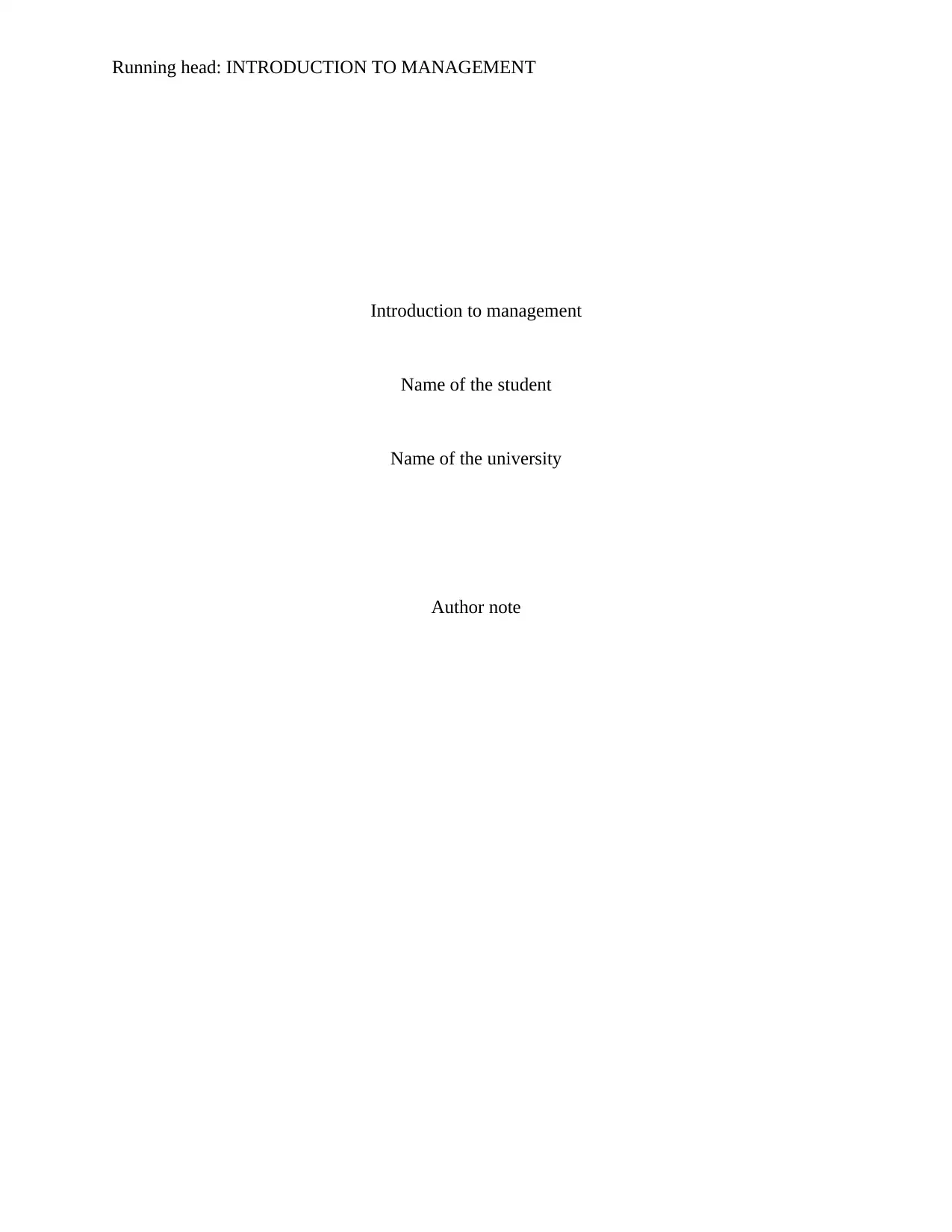
Running head: INTRODUCTION TO MANAGEMENT
Introduction to management
Name of the student
Name of the university
Author note
Introduction to management
Name of the student
Name of the university
Author note
Paraphrase This Document
Need a fresh take? Get an instant paraphrase of this document with our AI Paraphraser
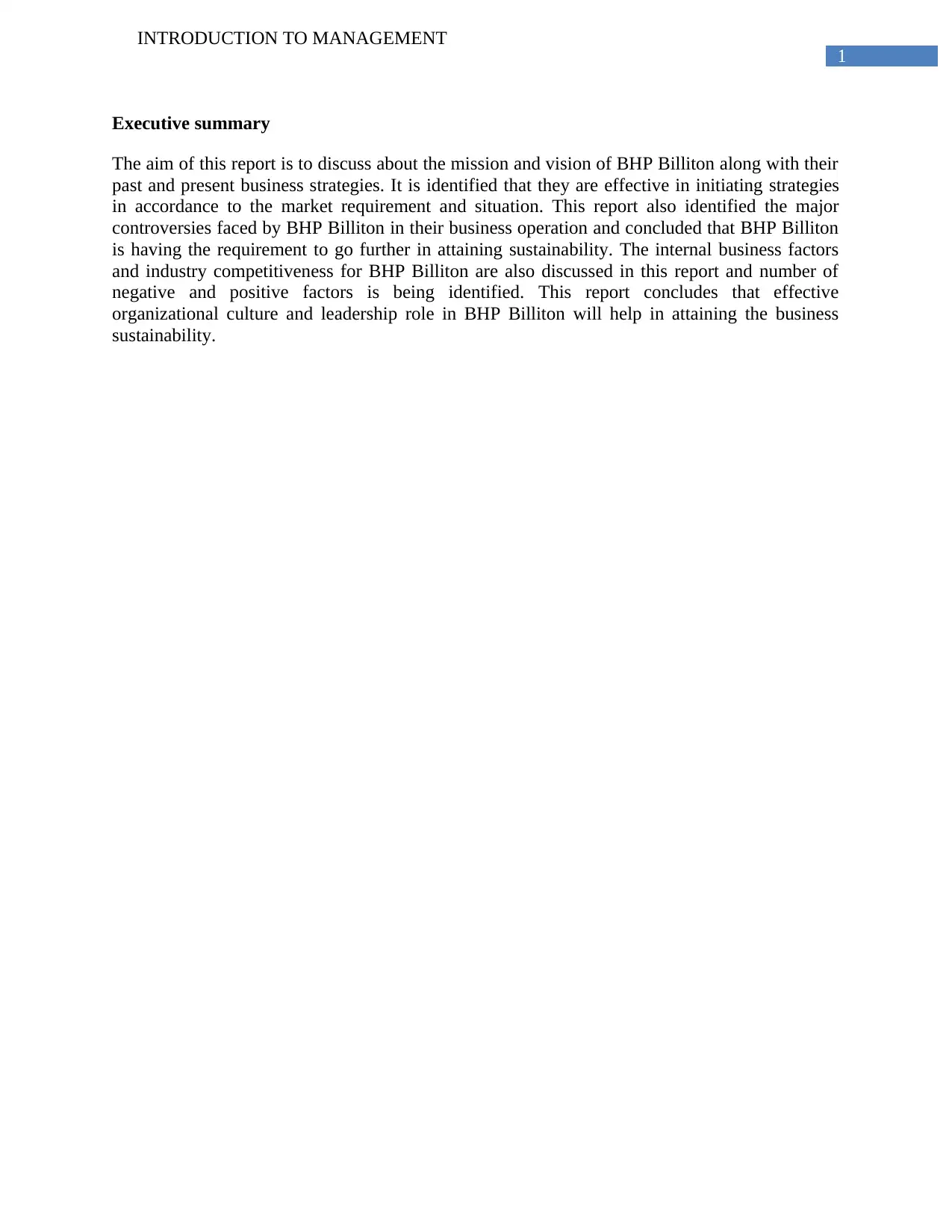
1
INTRODUCTION TO MANAGEMENT
Executive summary
The aim of this report is to discuss about the mission and vision of BHP Billiton along with their
past and present business strategies. It is identified that they are effective in initiating strategies
in accordance to the market requirement and situation. This report also identified the major
controversies faced by BHP Billiton in their business operation and concluded that BHP Billiton
is having the requirement to go further in attaining sustainability. The internal business factors
and industry competitiveness for BHP Billiton are also discussed in this report and number of
negative and positive factors is being identified. This report concludes that effective
organizational culture and leadership role in BHP Billiton will help in attaining the business
sustainability.
INTRODUCTION TO MANAGEMENT
Executive summary
The aim of this report is to discuss about the mission and vision of BHP Billiton along with their
past and present business strategies. It is identified that they are effective in initiating strategies
in accordance to the market requirement and situation. This report also identified the major
controversies faced by BHP Billiton in their business operation and concluded that BHP Billiton
is having the requirement to go further in attaining sustainability. The internal business factors
and industry competitiveness for BHP Billiton are also discussed in this report and number of
negative and positive factors is being identified. This report concludes that effective
organizational culture and leadership role in BHP Billiton will help in attaining the business
sustainability.
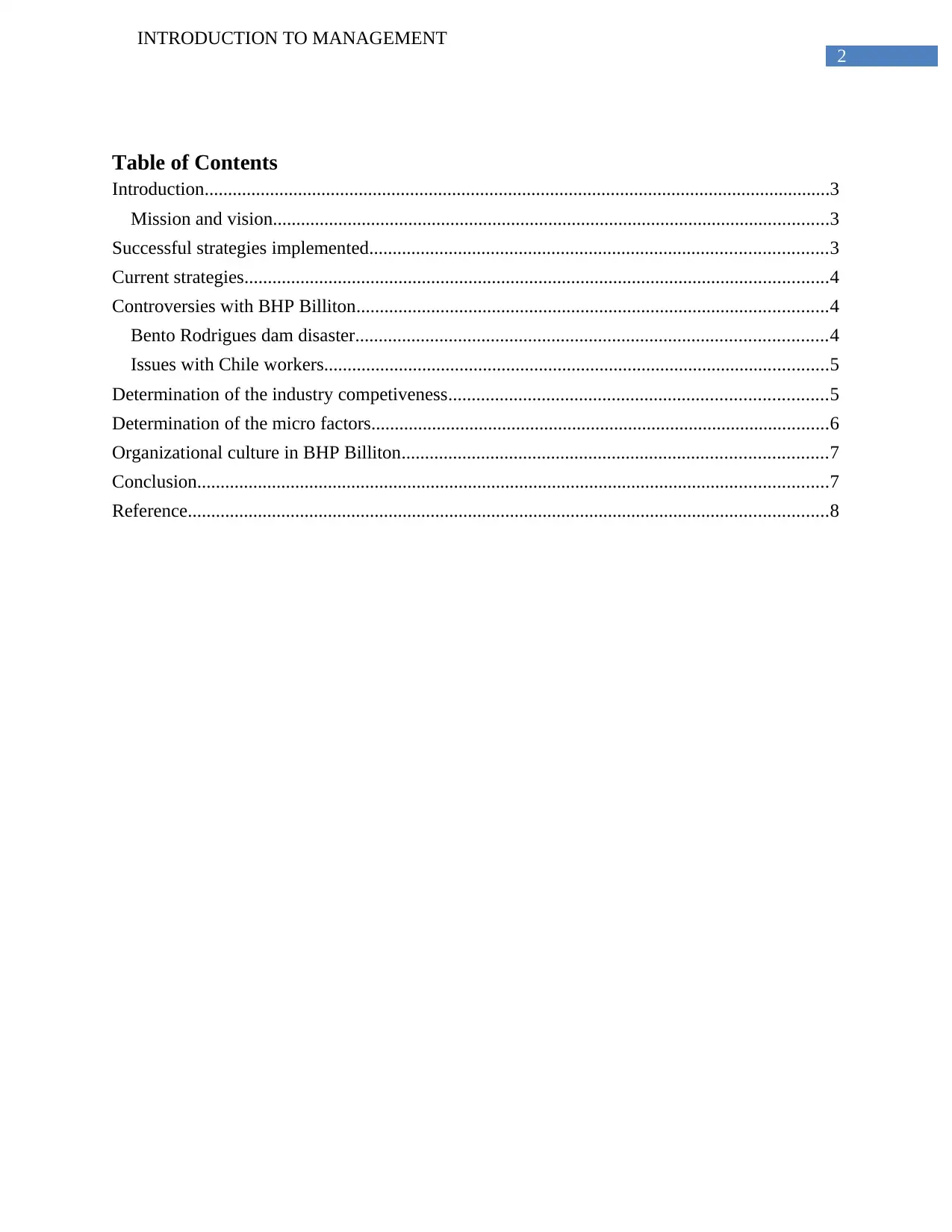
2
INTRODUCTION TO MANAGEMENT
Table of Contents
Introduction......................................................................................................................................3
Mission and vision.......................................................................................................................3
Successful strategies implemented..................................................................................................3
Current strategies.............................................................................................................................4
Controversies with BHP Billiton.....................................................................................................4
Bento Rodrigues dam disaster.....................................................................................................4
Issues with Chile workers............................................................................................................5
Determination of the industry competiveness.................................................................................5
Determination of the micro factors..................................................................................................6
Organizational culture in BHP Billiton...........................................................................................7
Conclusion.......................................................................................................................................7
Reference.........................................................................................................................................8
INTRODUCTION TO MANAGEMENT
Table of Contents
Introduction......................................................................................................................................3
Mission and vision.......................................................................................................................3
Successful strategies implemented..................................................................................................3
Current strategies.............................................................................................................................4
Controversies with BHP Billiton.....................................................................................................4
Bento Rodrigues dam disaster.....................................................................................................4
Issues with Chile workers............................................................................................................5
Determination of the industry competiveness.................................................................................5
Determination of the micro factors..................................................................................................6
Organizational culture in BHP Billiton...........................................................................................7
Conclusion.......................................................................................................................................7
Reference.........................................................................................................................................8
⊘ This is a preview!⊘
Do you want full access?
Subscribe today to unlock all pages.

Trusted by 1+ million students worldwide
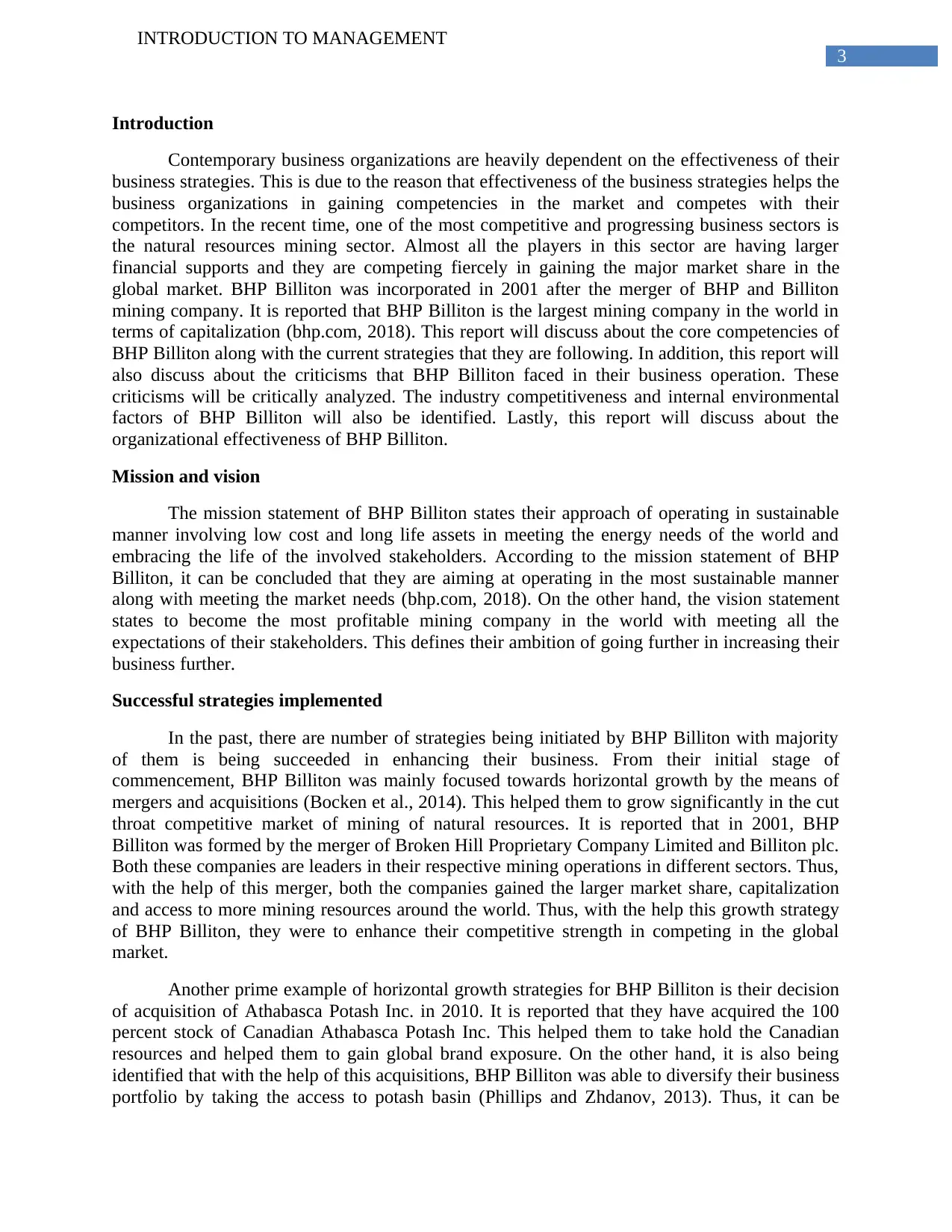
3
INTRODUCTION TO MANAGEMENT
Introduction
Contemporary business organizations are heavily dependent on the effectiveness of their
business strategies. This is due to the reason that effectiveness of the business strategies helps the
business organizations in gaining competencies in the market and competes with their
competitors. In the recent time, one of the most competitive and progressing business sectors is
the natural resources mining sector. Almost all the players in this sector are having larger
financial supports and they are competing fiercely in gaining the major market share in the
global market. BHP Billiton was incorporated in 2001 after the merger of BHP and Billiton
mining company. It is reported that BHP Billiton is the largest mining company in the world in
terms of capitalization (bhp.com, 2018). This report will discuss about the core competencies of
BHP Billiton along with the current strategies that they are following. In addition, this report will
also discuss about the criticisms that BHP Billiton faced in their business operation. These
criticisms will be critically analyzed. The industry competitiveness and internal environmental
factors of BHP Billiton will also be identified. Lastly, this report will discuss about the
organizational effectiveness of BHP Billiton.
Mission and vision
The mission statement of BHP Billiton states their approach of operating in sustainable
manner involving low cost and long life assets in meeting the energy needs of the world and
embracing the life of the involved stakeholders. According to the mission statement of BHP
Billiton, it can be concluded that they are aiming at operating in the most sustainable manner
along with meeting the market needs (bhp.com, 2018). On the other hand, the vision statement
states to become the most profitable mining company in the world with meeting all the
expectations of their stakeholders. This defines their ambition of going further in increasing their
business further.
Successful strategies implemented
In the past, there are number of strategies being initiated by BHP Billiton with majority
of them is being succeeded in enhancing their business. From their initial stage of
commencement, BHP Billiton was mainly focused towards horizontal growth by the means of
mergers and acquisitions (Bocken et al., 2014). This helped them to grow significantly in the cut
throat competitive market of mining of natural resources. It is reported that in 2001, BHP
Billiton was formed by the merger of Broken Hill Proprietary Company Limited and Billiton plc.
Both these companies are leaders in their respective mining operations in different sectors. Thus,
with the help of this merger, both the companies gained the larger market share, capitalization
and access to more mining resources around the world. Thus, with the help this growth strategy
of BHP Billiton, they were to enhance their competitive strength in competing in the global
market.
Another prime example of horizontal growth strategies for BHP Billiton is their decision
of acquisition of Athabasca Potash Inc. in 2010. It is reported that they have acquired the 100
percent stock of Canadian Athabasca Potash Inc. This helped them to take hold the Canadian
resources and helped them to gain global brand exposure. On the other hand, it is also being
identified that with the help of this acquisitions, BHP Billiton was able to diversify their business
portfolio by taking the access to potash basin (Phillips and Zhdanov, 2013). Thus, it can be
INTRODUCTION TO MANAGEMENT
Introduction
Contemporary business organizations are heavily dependent on the effectiveness of their
business strategies. This is due to the reason that effectiveness of the business strategies helps the
business organizations in gaining competencies in the market and competes with their
competitors. In the recent time, one of the most competitive and progressing business sectors is
the natural resources mining sector. Almost all the players in this sector are having larger
financial supports and they are competing fiercely in gaining the major market share in the
global market. BHP Billiton was incorporated in 2001 after the merger of BHP and Billiton
mining company. It is reported that BHP Billiton is the largest mining company in the world in
terms of capitalization (bhp.com, 2018). This report will discuss about the core competencies of
BHP Billiton along with the current strategies that they are following. In addition, this report will
also discuss about the criticisms that BHP Billiton faced in their business operation. These
criticisms will be critically analyzed. The industry competitiveness and internal environmental
factors of BHP Billiton will also be identified. Lastly, this report will discuss about the
organizational effectiveness of BHP Billiton.
Mission and vision
The mission statement of BHP Billiton states their approach of operating in sustainable
manner involving low cost and long life assets in meeting the energy needs of the world and
embracing the life of the involved stakeholders. According to the mission statement of BHP
Billiton, it can be concluded that they are aiming at operating in the most sustainable manner
along with meeting the market needs (bhp.com, 2018). On the other hand, the vision statement
states to become the most profitable mining company in the world with meeting all the
expectations of their stakeholders. This defines their ambition of going further in increasing their
business further.
Successful strategies implemented
In the past, there are number of strategies being initiated by BHP Billiton with majority
of them is being succeeded in enhancing their business. From their initial stage of
commencement, BHP Billiton was mainly focused towards horizontal growth by the means of
mergers and acquisitions (Bocken et al., 2014). This helped them to grow significantly in the cut
throat competitive market of mining of natural resources. It is reported that in 2001, BHP
Billiton was formed by the merger of Broken Hill Proprietary Company Limited and Billiton plc.
Both these companies are leaders in their respective mining operations in different sectors. Thus,
with the help of this merger, both the companies gained the larger market share, capitalization
and access to more mining resources around the world. Thus, with the help this growth strategy
of BHP Billiton, they were to enhance their competitive strength in competing in the global
market.
Another prime example of horizontal growth strategies for BHP Billiton is their decision
of acquisition of Athabasca Potash Inc. in 2010. It is reported that they have acquired the 100
percent stock of Canadian Athabasca Potash Inc. This helped them to take hold the Canadian
resources and helped them to gain global brand exposure. On the other hand, it is also being
identified that with the help of this acquisitions, BHP Billiton was able to diversify their business
portfolio by taking the access to potash basin (Phillips and Zhdanov, 2013). Thus, it can be
Paraphrase This Document
Need a fresh take? Get an instant paraphrase of this document with our AI Paraphraser
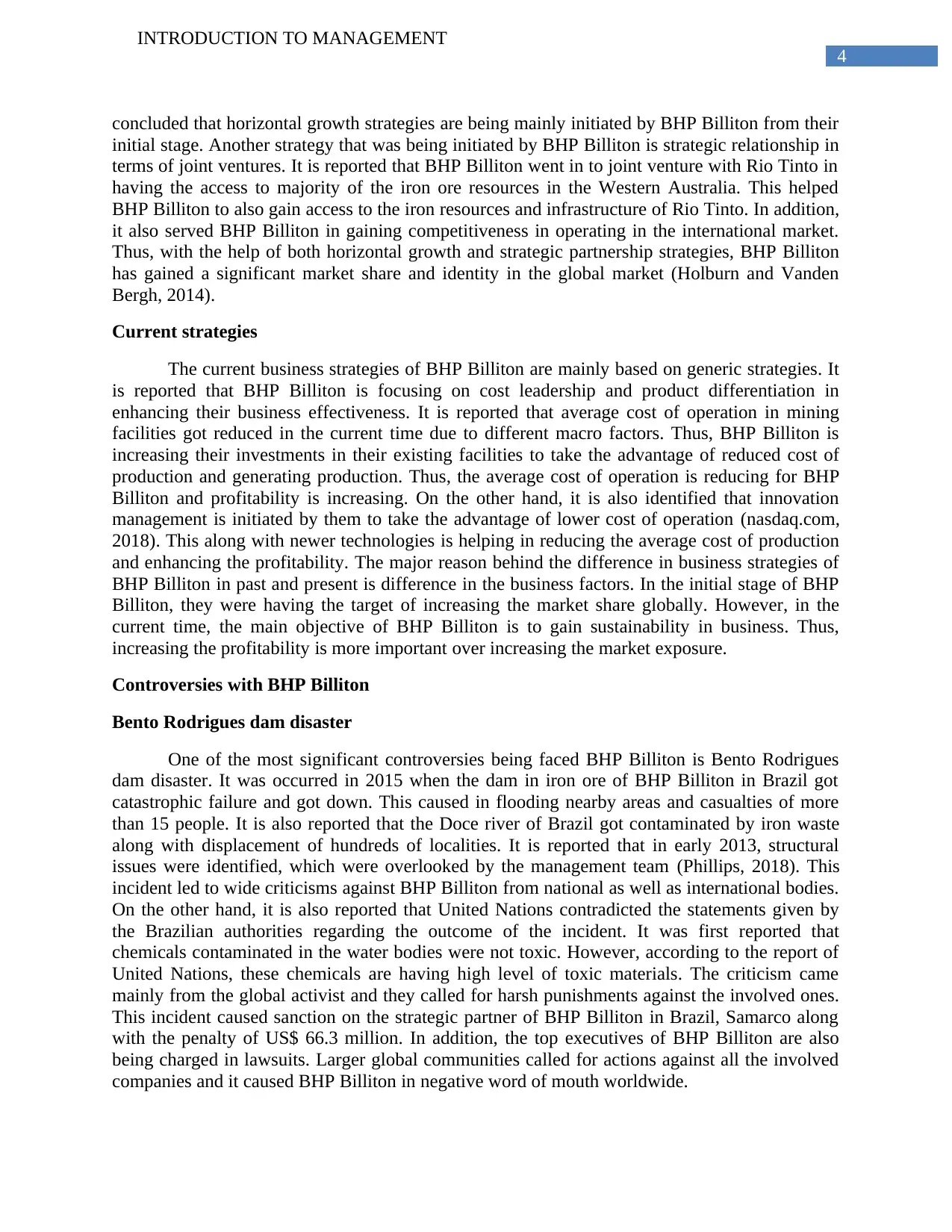
4
INTRODUCTION TO MANAGEMENT
concluded that horizontal growth strategies are being mainly initiated by BHP Billiton from their
initial stage. Another strategy that was being initiated by BHP Billiton is strategic relationship in
terms of joint ventures. It is reported that BHP Billiton went in to joint venture with Rio Tinto in
having the access to majority of the iron ore resources in the Western Australia. This helped
BHP Billiton to also gain access to the iron resources and infrastructure of Rio Tinto. In addition,
it also served BHP Billiton in gaining competitiveness in operating in the international market.
Thus, with the help of both horizontal growth and strategic partnership strategies, BHP Billiton
has gained a significant market share and identity in the global market (Holburn and Vanden
Bergh, 2014).
Current strategies
The current business strategies of BHP Billiton are mainly based on generic strategies. It
is reported that BHP Billiton is focusing on cost leadership and product differentiation in
enhancing their business effectiveness. It is reported that average cost of operation in mining
facilities got reduced in the current time due to different macro factors. Thus, BHP Billiton is
increasing their investments in their existing facilities to take the advantage of reduced cost of
production and generating production. Thus, the average cost of operation is reducing for BHP
Billiton and profitability is increasing. On the other hand, it is also identified that innovation
management is initiated by them to take the advantage of lower cost of operation (nasdaq.com,
2018). This along with newer technologies is helping in reducing the average cost of production
and enhancing the profitability. The major reason behind the difference in business strategies of
BHP Billiton in past and present is difference in the business factors. In the initial stage of BHP
Billiton, they were having the target of increasing the market share globally. However, in the
current time, the main objective of BHP Billiton is to gain sustainability in business. Thus,
increasing the profitability is more important over increasing the market exposure.
Controversies with BHP Billiton
Bento Rodrigues dam disaster
One of the most significant controversies being faced BHP Billiton is Bento Rodrigues
dam disaster. It was occurred in 2015 when the dam in iron ore of BHP Billiton in Brazil got
catastrophic failure and got down. This caused in flooding nearby areas and casualties of more
than 15 people. It is also reported that the Doce river of Brazil got contaminated by iron waste
along with displacement of hundreds of localities. It is reported that in early 2013, structural
issues were identified, which were overlooked by the management team (Phillips, 2018). This
incident led to wide criticisms against BHP Billiton from national as well as international bodies.
On the other hand, it is also reported that United Nations contradicted the statements given by
the Brazilian authorities regarding the outcome of the incident. It was first reported that
chemicals contaminated in the water bodies were not toxic. However, according to the report of
United Nations, these chemicals are having high level of toxic materials. The criticism came
mainly from the global activist and they called for harsh punishments against the involved ones.
This incident caused sanction on the strategic partner of BHP Billiton in Brazil, Samarco along
with the penalty of US$ 66.3 million. In addition, the top executives of BHP Billiton are also
being charged in lawsuits. Larger global communities called for actions against all the involved
companies and it caused BHP Billiton in negative word of mouth worldwide.
INTRODUCTION TO MANAGEMENT
concluded that horizontal growth strategies are being mainly initiated by BHP Billiton from their
initial stage. Another strategy that was being initiated by BHP Billiton is strategic relationship in
terms of joint ventures. It is reported that BHP Billiton went in to joint venture with Rio Tinto in
having the access to majority of the iron ore resources in the Western Australia. This helped
BHP Billiton to also gain access to the iron resources and infrastructure of Rio Tinto. In addition,
it also served BHP Billiton in gaining competitiveness in operating in the international market.
Thus, with the help of both horizontal growth and strategic partnership strategies, BHP Billiton
has gained a significant market share and identity in the global market (Holburn and Vanden
Bergh, 2014).
Current strategies
The current business strategies of BHP Billiton are mainly based on generic strategies. It
is reported that BHP Billiton is focusing on cost leadership and product differentiation in
enhancing their business effectiveness. It is reported that average cost of operation in mining
facilities got reduced in the current time due to different macro factors. Thus, BHP Billiton is
increasing their investments in their existing facilities to take the advantage of reduced cost of
production and generating production. Thus, the average cost of operation is reducing for BHP
Billiton and profitability is increasing. On the other hand, it is also identified that innovation
management is initiated by them to take the advantage of lower cost of operation (nasdaq.com,
2018). This along with newer technologies is helping in reducing the average cost of production
and enhancing the profitability. The major reason behind the difference in business strategies of
BHP Billiton in past and present is difference in the business factors. In the initial stage of BHP
Billiton, they were having the target of increasing the market share globally. However, in the
current time, the main objective of BHP Billiton is to gain sustainability in business. Thus,
increasing the profitability is more important over increasing the market exposure.
Controversies with BHP Billiton
Bento Rodrigues dam disaster
One of the most significant controversies being faced BHP Billiton is Bento Rodrigues
dam disaster. It was occurred in 2015 when the dam in iron ore of BHP Billiton in Brazil got
catastrophic failure and got down. This caused in flooding nearby areas and casualties of more
than 15 people. It is also reported that the Doce river of Brazil got contaminated by iron waste
along with displacement of hundreds of localities. It is reported that in early 2013, structural
issues were identified, which were overlooked by the management team (Phillips, 2018). This
incident led to wide criticisms against BHP Billiton from national as well as international bodies.
On the other hand, it is also reported that United Nations contradicted the statements given by
the Brazilian authorities regarding the outcome of the incident. It was first reported that
chemicals contaminated in the water bodies were not toxic. However, according to the report of
United Nations, these chemicals are having high level of toxic materials. The criticism came
mainly from the global activist and they called for harsh punishments against the involved ones.
This incident caused sanction on the strategic partner of BHP Billiton in Brazil, Samarco along
with the penalty of US$ 66.3 million. In addition, the top executives of BHP Billiton are also
being charged in lawsuits. Larger global communities called for actions against all the involved
companies and it caused BHP Billiton in negative word of mouth worldwide.
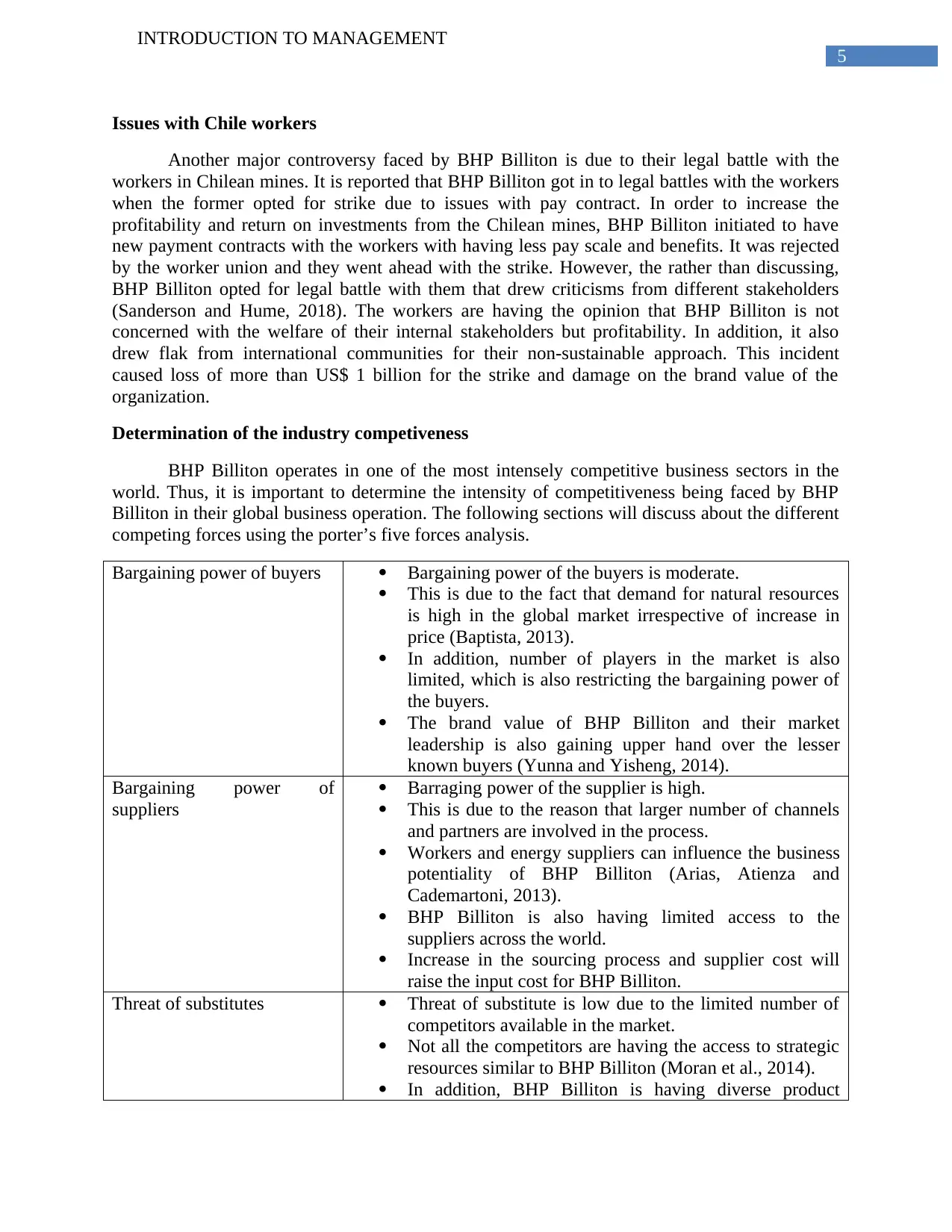
5
INTRODUCTION TO MANAGEMENT
Issues with Chile workers
Another major controversy faced by BHP Billiton is due to their legal battle with the
workers in Chilean mines. It is reported that BHP Billiton got in to legal battles with the workers
when the former opted for strike due to issues with pay contract. In order to increase the
profitability and return on investments from the Chilean mines, BHP Billiton initiated to have
new payment contracts with the workers with having less pay scale and benefits. It was rejected
by the worker union and they went ahead with the strike. However, the rather than discussing,
BHP Billiton opted for legal battle with them that drew criticisms from different stakeholders
(Sanderson and Hume, 2018). The workers are having the opinion that BHP Billiton is not
concerned with the welfare of their internal stakeholders but profitability. In addition, it also
drew flak from international communities for their non-sustainable approach. This incident
caused loss of more than US$ 1 billion for the strike and damage on the brand value of the
organization.
Determination of the industry competiveness
BHP Billiton operates in one of the most intensely competitive business sectors in the
world. Thus, it is important to determine the intensity of competitiveness being faced by BHP
Billiton in their global business operation. The following sections will discuss about the different
competing forces using the porter’s five forces analysis.
Bargaining power of buyers Bargaining power of the buyers is moderate.
This is due to the fact that demand for natural resources
is high in the global market irrespective of increase in
price (Baptista, 2013).
In addition, number of players in the market is also
limited, which is also restricting the bargaining power of
the buyers.
The brand value of BHP Billiton and their market
leadership is also gaining upper hand over the lesser
known buyers (Yunna and Yisheng, 2014).
Bargaining power of
suppliers
Barraging power of the supplier is high.
This is due to the reason that larger number of channels
and partners are involved in the process.
Workers and energy suppliers can influence the business
potentiality of BHP Billiton (Arias, Atienza and
Cademartoni, 2013).
BHP Billiton is also having limited access to the
suppliers across the world.
Increase in the sourcing process and supplier cost will
raise the input cost for BHP Billiton.
Threat of substitutes Threat of substitute is low due to the limited number of
competitors available in the market.
Not all the competitors are having the access to strategic
resources similar to BHP Billiton (Moran et al., 2014).
In addition, BHP Billiton is having diverse product
INTRODUCTION TO MANAGEMENT
Issues with Chile workers
Another major controversy faced by BHP Billiton is due to their legal battle with the
workers in Chilean mines. It is reported that BHP Billiton got in to legal battles with the workers
when the former opted for strike due to issues with pay contract. In order to increase the
profitability and return on investments from the Chilean mines, BHP Billiton initiated to have
new payment contracts with the workers with having less pay scale and benefits. It was rejected
by the worker union and they went ahead with the strike. However, the rather than discussing,
BHP Billiton opted for legal battle with them that drew criticisms from different stakeholders
(Sanderson and Hume, 2018). The workers are having the opinion that BHP Billiton is not
concerned with the welfare of their internal stakeholders but profitability. In addition, it also
drew flak from international communities for their non-sustainable approach. This incident
caused loss of more than US$ 1 billion for the strike and damage on the brand value of the
organization.
Determination of the industry competiveness
BHP Billiton operates in one of the most intensely competitive business sectors in the
world. Thus, it is important to determine the intensity of competitiveness being faced by BHP
Billiton in their global business operation. The following sections will discuss about the different
competing forces using the porter’s five forces analysis.
Bargaining power of buyers Bargaining power of the buyers is moderate.
This is due to the fact that demand for natural resources
is high in the global market irrespective of increase in
price (Baptista, 2013).
In addition, number of players in the market is also
limited, which is also restricting the bargaining power of
the buyers.
The brand value of BHP Billiton and their market
leadership is also gaining upper hand over the lesser
known buyers (Yunna and Yisheng, 2014).
Bargaining power of
suppliers
Barraging power of the supplier is high.
This is due to the reason that larger number of channels
and partners are involved in the process.
Workers and energy suppliers can influence the business
potentiality of BHP Billiton (Arias, Atienza and
Cademartoni, 2013).
BHP Billiton is also having limited access to the
suppliers across the world.
Increase in the sourcing process and supplier cost will
raise the input cost for BHP Billiton.
Threat of substitutes Threat of substitute is low due to the limited number of
competitors available in the market.
Not all the competitors are having the access to strategic
resources similar to BHP Billiton (Moran et al., 2014).
In addition, BHP Billiton is having diverse product
⊘ This is a preview!⊘
Do you want full access?
Subscribe today to unlock all pages.

Trusted by 1+ million students worldwide
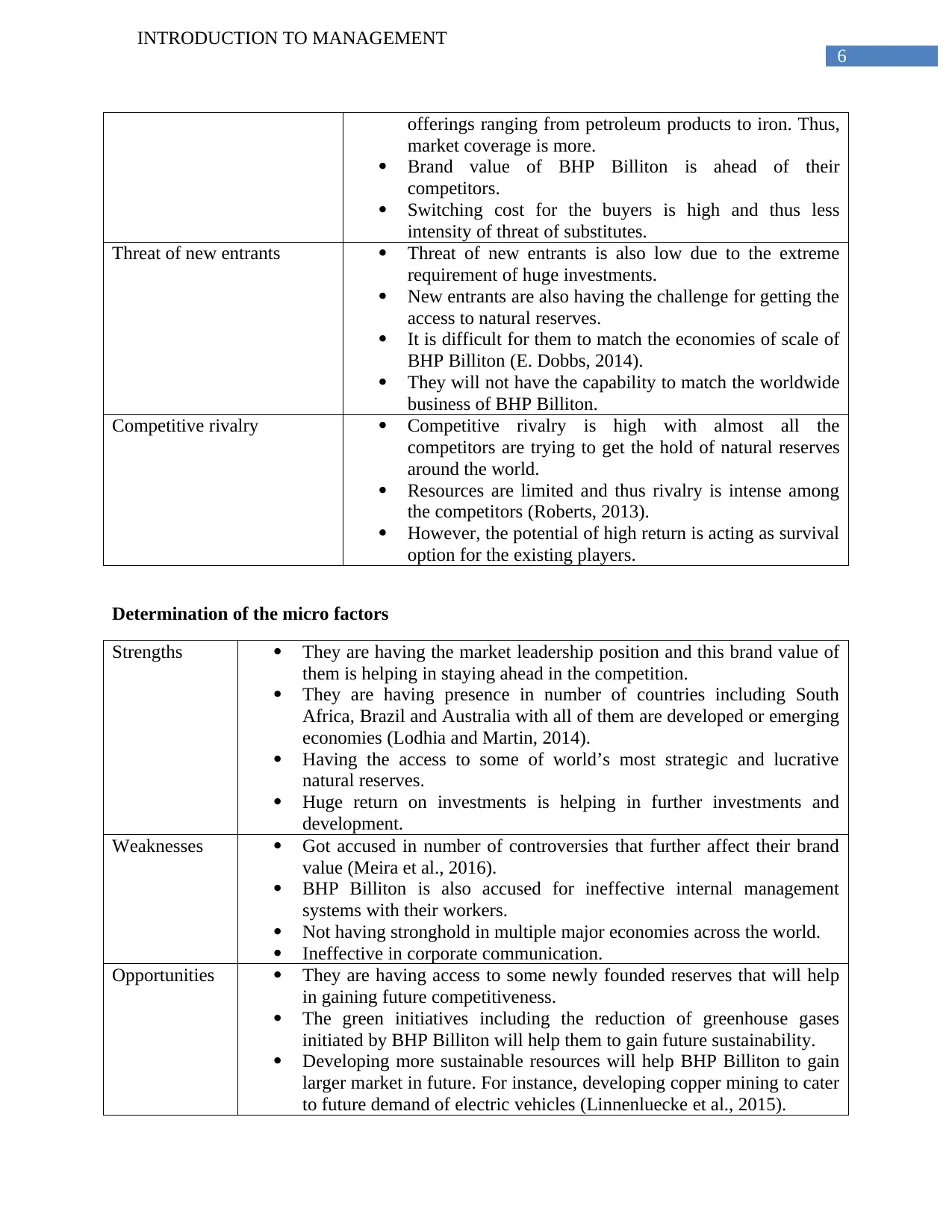
6
INTRODUCTION TO MANAGEMENT
offerings ranging from petroleum products to iron. Thus,
market coverage is more.
Brand value of BHP Billiton is ahead of their
competitors.
Switching cost for the buyers is high and thus less
intensity of threat of substitutes.
Threat of new entrants Threat of new entrants is also low due to the extreme
requirement of huge investments.
New entrants are also having the challenge for getting the
access to natural reserves.
It is difficult for them to match the economies of scale of
BHP Billiton (E. Dobbs, 2014).
They will not have the capability to match the worldwide
business of BHP Billiton.
Competitive rivalry Competitive rivalry is high with almost all the
competitors are trying to get the hold of natural reserves
around the world.
Resources are limited and thus rivalry is intense among
the competitors (Roberts, 2013).
However, the potential of high return is acting as survival
option for the existing players.
Determination of the micro factors
Strengths They are having the market leadership position and this brand value of
them is helping in staying ahead in the competition.
They are having presence in number of countries including South
Africa, Brazil and Australia with all of them are developed or emerging
economies (Lodhia and Martin, 2014).
Having the access to some of world’s most strategic and lucrative
natural reserves.
Huge return on investments is helping in further investments and
development.
Weaknesses Got accused in number of controversies that further affect their brand
value (Meira et al., 2016).
BHP Billiton is also accused for ineffective internal management
systems with their workers.
Not having stronghold in multiple major economies across the world.
Ineffective in corporate communication.
Opportunities They are having access to some newly founded reserves that will help
in gaining future competitiveness.
The green initiatives including the reduction of greenhouse gases
initiated by BHP Billiton will help them to gain future sustainability.
Developing more sustainable resources will help BHP Billiton to gain
larger market in future. For instance, developing copper mining to cater
to future demand of electric vehicles (Linnenluecke et al., 2015).
INTRODUCTION TO MANAGEMENT
offerings ranging from petroleum products to iron. Thus,
market coverage is more.
Brand value of BHP Billiton is ahead of their
competitors.
Switching cost for the buyers is high and thus less
intensity of threat of substitutes.
Threat of new entrants Threat of new entrants is also low due to the extreme
requirement of huge investments.
New entrants are also having the challenge for getting the
access to natural reserves.
It is difficult for them to match the economies of scale of
BHP Billiton (E. Dobbs, 2014).
They will not have the capability to match the worldwide
business of BHP Billiton.
Competitive rivalry Competitive rivalry is high with almost all the
competitors are trying to get the hold of natural reserves
around the world.
Resources are limited and thus rivalry is intense among
the competitors (Roberts, 2013).
However, the potential of high return is acting as survival
option for the existing players.
Determination of the micro factors
Strengths They are having the market leadership position and this brand value of
them is helping in staying ahead in the competition.
They are having presence in number of countries including South
Africa, Brazil and Australia with all of them are developed or emerging
economies (Lodhia and Martin, 2014).
Having the access to some of world’s most strategic and lucrative
natural reserves.
Huge return on investments is helping in further investments and
development.
Weaknesses Got accused in number of controversies that further affect their brand
value (Meira et al., 2016).
BHP Billiton is also accused for ineffective internal management
systems with their workers.
Not having stronghold in multiple major economies across the world.
Ineffective in corporate communication.
Opportunities They are having access to some newly founded reserves that will help
in gaining future competitiveness.
The green initiatives including the reduction of greenhouse gases
initiated by BHP Billiton will help them to gain future sustainability.
Developing more sustainable resources will help BHP Billiton to gain
larger market in future. For instance, developing copper mining to cater
to future demand of electric vehicles (Linnenluecke et al., 2015).
Paraphrase This Document
Need a fresh take? Get an instant paraphrase of this document with our AI Paraphraser
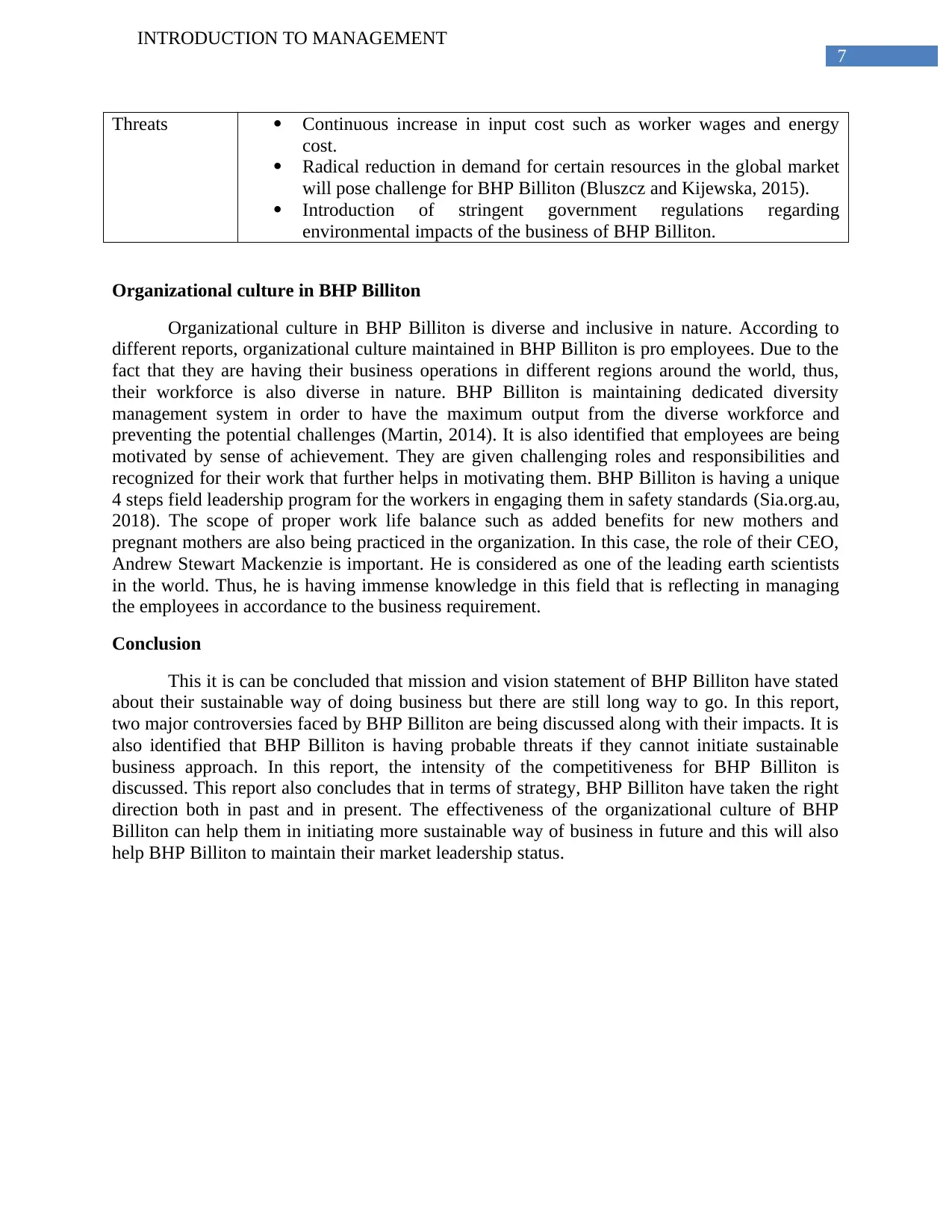
7
INTRODUCTION TO MANAGEMENT
Threats Continuous increase in input cost such as worker wages and energy
cost.
Radical reduction in demand for certain resources in the global market
will pose challenge for BHP Billiton (Bluszcz and Kijewska, 2015).
Introduction of stringent government regulations regarding
environmental impacts of the business of BHP Billiton.
Organizational culture in BHP Billiton
Organizational culture in BHP Billiton is diverse and inclusive in nature. According to
different reports, organizational culture maintained in BHP Billiton is pro employees. Due to the
fact that they are having their business operations in different regions around the world, thus,
their workforce is also diverse in nature. BHP Billiton is maintaining dedicated diversity
management system in order to have the maximum output from the diverse workforce and
preventing the potential challenges (Martin, 2014). It is also identified that employees are being
motivated by sense of achievement. They are given challenging roles and responsibilities and
recognized for their work that further helps in motivating them. BHP Billiton is having a unique
4 steps field leadership program for the workers in engaging them in safety standards (Sia.org.au,
2018). The scope of proper work life balance such as added benefits for new mothers and
pregnant mothers are also being practiced in the organization. In this case, the role of their CEO,
Andrew Stewart Mackenzie is important. He is considered as one of the leading earth scientists
in the world. Thus, he is having immense knowledge in this field that is reflecting in managing
the employees in accordance to the business requirement.
Conclusion
This it is can be concluded that mission and vision statement of BHP Billiton have stated
about their sustainable way of doing business but there are still long way to go. In this report,
two major controversies faced by BHP Billiton are being discussed along with their impacts. It is
also identified that BHP Billiton is having probable threats if they cannot initiate sustainable
business approach. In this report, the intensity of the competitiveness for BHP Billiton is
discussed. This report also concludes that in terms of strategy, BHP Billiton have taken the right
direction both in past and in present. The effectiveness of the organizational culture of BHP
Billiton can help them in initiating more sustainable way of business in future and this will also
help BHP Billiton to maintain their market leadership status.
INTRODUCTION TO MANAGEMENT
Threats Continuous increase in input cost such as worker wages and energy
cost.
Radical reduction in demand for certain resources in the global market
will pose challenge for BHP Billiton (Bluszcz and Kijewska, 2015).
Introduction of stringent government regulations regarding
environmental impacts of the business of BHP Billiton.
Organizational culture in BHP Billiton
Organizational culture in BHP Billiton is diverse and inclusive in nature. According to
different reports, organizational culture maintained in BHP Billiton is pro employees. Due to the
fact that they are having their business operations in different regions around the world, thus,
their workforce is also diverse in nature. BHP Billiton is maintaining dedicated diversity
management system in order to have the maximum output from the diverse workforce and
preventing the potential challenges (Martin, 2014). It is also identified that employees are being
motivated by sense of achievement. They are given challenging roles and responsibilities and
recognized for their work that further helps in motivating them. BHP Billiton is having a unique
4 steps field leadership program for the workers in engaging them in safety standards (Sia.org.au,
2018). The scope of proper work life balance such as added benefits for new mothers and
pregnant mothers are also being practiced in the organization. In this case, the role of their CEO,
Andrew Stewart Mackenzie is important. He is considered as one of the leading earth scientists
in the world. Thus, he is having immense knowledge in this field that is reflecting in managing
the employees in accordance to the business requirement.
Conclusion
This it is can be concluded that mission and vision statement of BHP Billiton have stated
about their sustainable way of doing business but there are still long way to go. In this report,
two major controversies faced by BHP Billiton are being discussed along with their impacts. It is
also identified that BHP Billiton is having probable threats if they cannot initiate sustainable
business approach. In this report, the intensity of the competitiveness for BHP Billiton is
discussed. This report also concludes that in terms of strategy, BHP Billiton have taken the right
direction both in past and in present. The effectiveness of the organizational culture of BHP
Billiton can help them in initiating more sustainable way of business in future and this will also
help BHP Billiton to maintain their market leadership status.
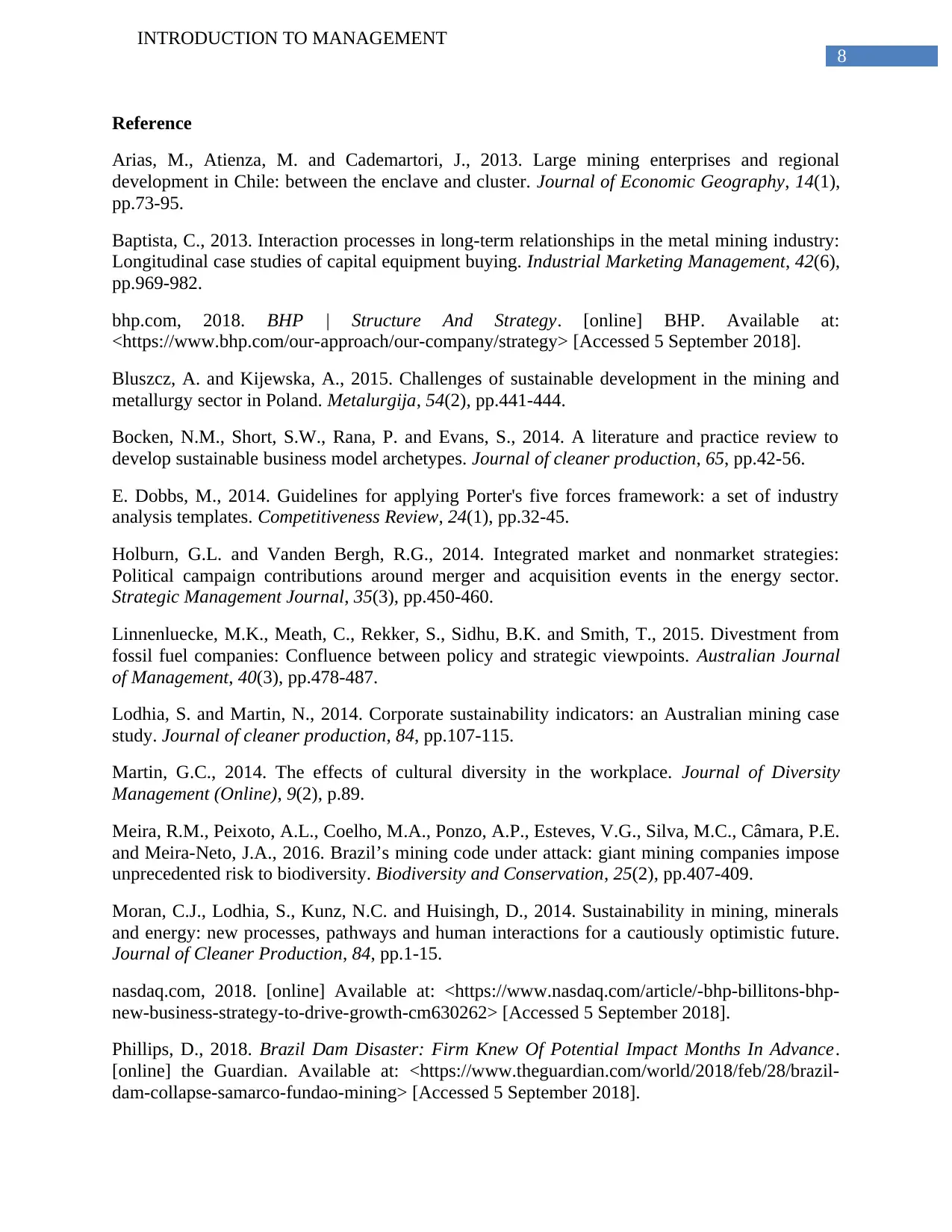
8
INTRODUCTION TO MANAGEMENT
Reference
Arias, M., Atienza, M. and Cademartori, J., 2013. Large mining enterprises and regional
development in Chile: between the enclave and cluster. Journal of Economic Geography, 14(1),
pp.73-95.
Baptista, C., 2013. Interaction processes in long-term relationships in the metal mining industry:
Longitudinal case studies of capital equipment buying. Industrial Marketing Management, 42(6),
pp.969-982.
bhp.com, 2018. BHP | Structure And Strategy. [online] BHP. Available at:
<https://www.bhp.com/our-approach/our-company/strategy> [Accessed 5 September 2018].
Bluszcz, A. and Kijewska, A., 2015. Challenges of sustainable development in the mining and
metallurgy sector in Poland. Metalurgija, 54(2), pp.441-444.
Bocken, N.M., Short, S.W., Rana, P. and Evans, S., 2014. A literature and practice review to
develop sustainable business model archetypes. Journal of cleaner production, 65, pp.42-56.
E. Dobbs, M., 2014. Guidelines for applying Porter's five forces framework: a set of industry
analysis templates. Competitiveness Review, 24(1), pp.32-45.
Holburn, G.L. and Vanden Bergh, R.G., 2014. Integrated market and nonmarket strategies:
Political campaign contributions around merger and acquisition events in the energy sector.
Strategic Management Journal, 35(3), pp.450-460.
Linnenluecke, M.K., Meath, C., Rekker, S., Sidhu, B.K. and Smith, T., 2015. Divestment from
fossil fuel companies: Confluence between policy and strategic viewpoints. Australian Journal
of Management, 40(3), pp.478-487.
Lodhia, S. and Martin, N., 2014. Corporate sustainability indicators: an Australian mining case
study. Journal of cleaner production, 84, pp.107-115.
Martin, G.C., 2014. The effects of cultural diversity in the workplace. Journal of Diversity
Management (Online), 9(2), p.89.
Meira, R.M., Peixoto, A.L., Coelho, M.A., Ponzo, A.P., Esteves, V.G., Silva, M.C., Câmara, P.E.
and Meira-Neto, J.A., 2016. Brazil’s mining code under attack: giant mining companies impose
unprecedented risk to biodiversity. Biodiversity and Conservation, 25(2), pp.407-409.
Moran, C.J., Lodhia, S., Kunz, N.C. and Huisingh, D., 2014. Sustainability in mining, minerals
and energy: new processes, pathways and human interactions for a cautiously optimistic future.
Journal of Cleaner Production, 84, pp.1-15.
nasdaq.com, 2018. [online] Available at: <https://www.nasdaq.com/article/-bhp-billitons-bhp-
new-business-strategy-to-drive-growth-cm630262> [Accessed 5 September 2018].
Phillips, D., 2018. Brazil Dam Disaster: Firm Knew Of Potential Impact Months In Advance.
[online] the Guardian. Available at: <https://www.theguardian.com/world/2018/feb/28/brazil-
dam-collapse-samarco-fundao-mining> [Accessed 5 September 2018].
INTRODUCTION TO MANAGEMENT
Reference
Arias, M., Atienza, M. and Cademartori, J., 2013. Large mining enterprises and regional
development in Chile: between the enclave and cluster. Journal of Economic Geography, 14(1),
pp.73-95.
Baptista, C., 2013. Interaction processes in long-term relationships in the metal mining industry:
Longitudinal case studies of capital equipment buying. Industrial Marketing Management, 42(6),
pp.969-982.
bhp.com, 2018. BHP | Structure And Strategy. [online] BHP. Available at:
<https://www.bhp.com/our-approach/our-company/strategy> [Accessed 5 September 2018].
Bluszcz, A. and Kijewska, A., 2015. Challenges of sustainable development in the mining and
metallurgy sector in Poland. Metalurgija, 54(2), pp.441-444.
Bocken, N.M., Short, S.W., Rana, P. and Evans, S., 2014. A literature and practice review to
develop sustainable business model archetypes. Journal of cleaner production, 65, pp.42-56.
E. Dobbs, M., 2014. Guidelines for applying Porter's five forces framework: a set of industry
analysis templates. Competitiveness Review, 24(1), pp.32-45.
Holburn, G.L. and Vanden Bergh, R.G., 2014. Integrated market and nonmarket strategies:
Political campaign contributions around merger and acquisition events in the energy sector.
Strategic Management Journal, 35(3), pp.450-460.
Linnenluecke, M.K., Meath, C., Rekker, S., Sidhu, B.K. and Smith, T., 2015. Divestment from
fossil fuel companies: Confluence between policy and strategic viewpoints. Australian Journal
of Management, 40(3), pp.478-487.
Lodhia, S. and Martin, N., 2014. Corporate sustainability indicators: an Australian mining case
study. Journal of cleaner production, 84, pp.107-115.
Martin, G.C., 2014. The effects of cultural diversity in the workplace. Journal of Diversity
Management (Online), 9(2), p.89.
Meira, R.M., Peixoto, A.L., Coelho, M.A., Ponzo, A.P., Esteves, V.G., Silva, M.C., Câmara, P.E.
and Meira-Neto, J.A., 2016. Brazil’s mining code under attack: giant mining companies impose
unprecedented risk to biodiversity. Biodiversity and Conservation, 25(2), pp.407-409.
Moran, C.J., Lodhia, S., Kunz, N.C. and Huisingh, D., 2014. Sustainability in mining, minerals
and energy: new processes, pathways and human interactions for a cautiously optimistic future.
Journal of Cleaner Production, 84, pp.1-15.
nasdaq.com, 2018. [online] Available at: <https://www.nasdaq.com/article/-bhp-billitons-bhp-
new-business-strategy-to-drive-growth-cm630262> [Accessed 5 September 2018].
Phillips, D., 2018. Brazil Dam Disaster: Firm Knew Of Potential Impact Months In Advance.
[online] the Guardian. Available at: <https://www.theguardian.com/world/2018/feb/28/brazil-
dam-collapse-samarco-fundao-mining> [Accessed 5 September 2018].
⊘ This is a preview!⊘
Do you want full access?
Subscribe today to unlock all pages.

Trusted by 1+ million students worldwide
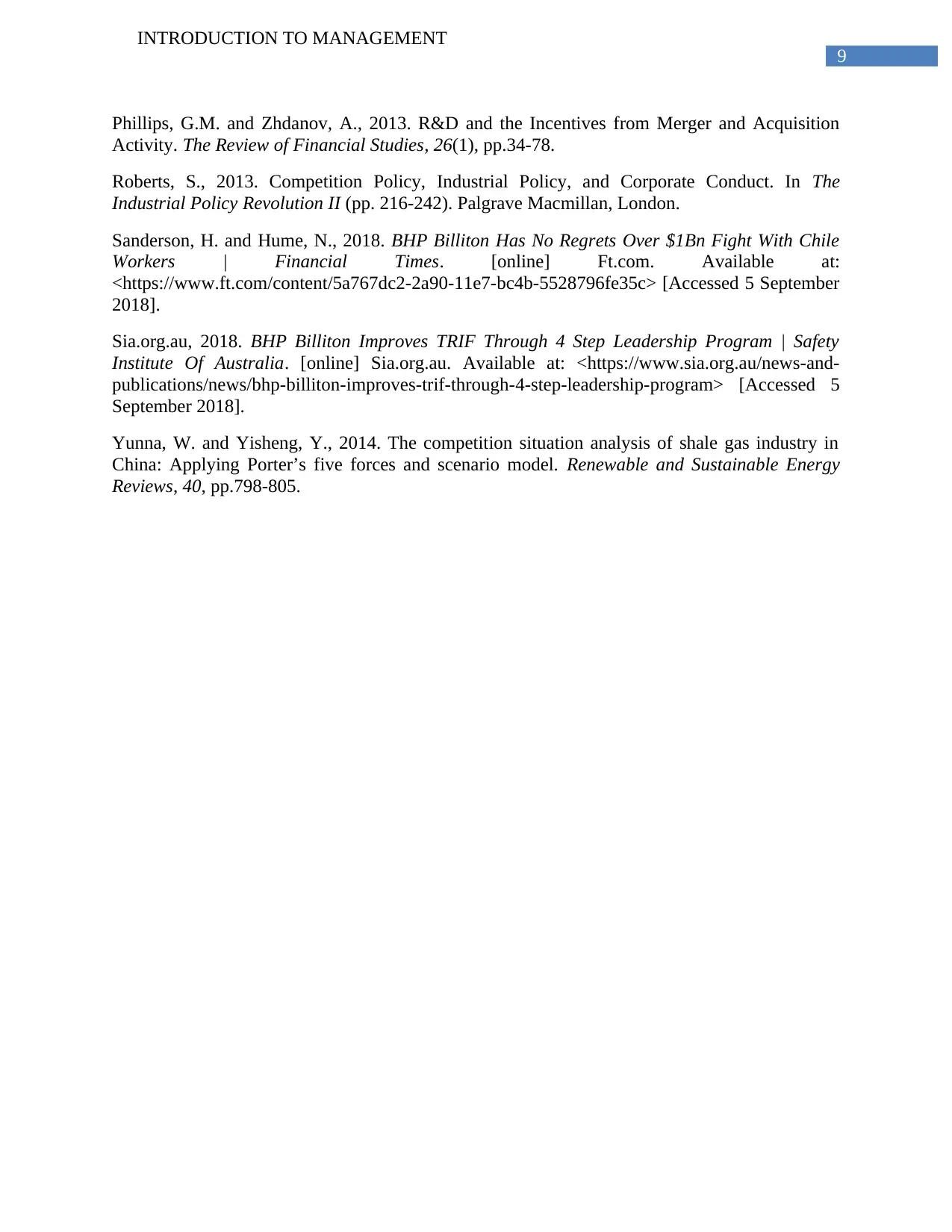
9
INTRODUCTION TO MANAGEMENT
Phillips, G.M. and Zhdanov, A., 2013. R&D and the Incentives from Merger and Acquisition
Activity. The Review of Financial Studies, 26(1), pp.34-78.
Roberts, S., 2013. Competition Policy, Industrial Policy, and Corporate Conduct. In The
Industrial Policy Revolution II (pp. 216-242). Palgrave Macmillan, London.
Sanderson, H. and Hume, N., 2018. BHP Billiton Has No Regrets Over $1Bn Fight With Chile
Workers | Financial Times. [online] Ft.com. Available at:
<https://www.ft.com/content/5a767dc2-2a90-11e7-bc4b-5528796fe35c> [Accessed 5 September
2018].
Sia.org.au, 2018. BHP Billiton Improves TRIF Through 4 Step Leadership Program | Safety
Institute Of Australia. [online] Sia.org.au. Available at: <https://www.sia.org.au/news-and-
publications/news/bhp-billiton-improves-trif-through-4-step-leadership-program> [Accessed 5
September 2018].
Yunna, W. and Yisheng, Y., 2014. The competition situation analysis of shale gas industry in
China: Applying Porter’s five forces and scenario model. Renewable and Sustainable Energy
Reviews, 40, pp.798-805.
INTRODUCTION TO MANAGEMENT
Phillips, G.M. and Zhdanov, A., 2013. R&D and the Incentives from Merger and Acquisition
Activity. The Review of Financial Studies, 26(1), pp.34-78.
Roberts, S., 2013. Competition Policy, Industrial Policy, and Corporate Conduct. In The
Industrial Policy Revolution II (pp. 216-242). Palgrave Macmillan, London.
Sanderson, H. and Hume, N., 2018. BHP Billiton Has No Regrets Over $1Bn Fight With Chile
Workers | Financial Times. [online] Ft.com. Available at:
<https://www.ft.com/content/5a767dc2-2a90-11e7-bc4b-5528796fe35c> [Accessed 5 September
2018].
Sia.org.au, 2018. BHP Billiton Improves TRIF Through 4 Step Leadership Program | Safety
Institute Of Australia. [online] Sia.org.au. Available at: <https://www.sia.org.au/news-and-
publications/news/bhp-billiton-improves-trif-through-4-step-leadership-program> [Accessed 5
September 2018].
Yunna, W. and Yisheng, Y., 2014. The competition situation analysis of shale gas industry in
China: Applying Porter’s five forces and scenario model. Renewable and Sustainable Energy
Reviews, 40, pp.798-805.
1 out of 10
Related Documents
Your All-in-One AI-Powered Toolkit for Academic Success.
+13062052269
info@desklib.com
Available 24*7 on WhatsApp / Email
![[object Object]](/_next/static/media/star-bottom.7253800d.svg)
Unlock your academic potential
Copyright © 2020–2025 A2Z Services. All Rights Reserved. Developed and managed by ZUCOL.





